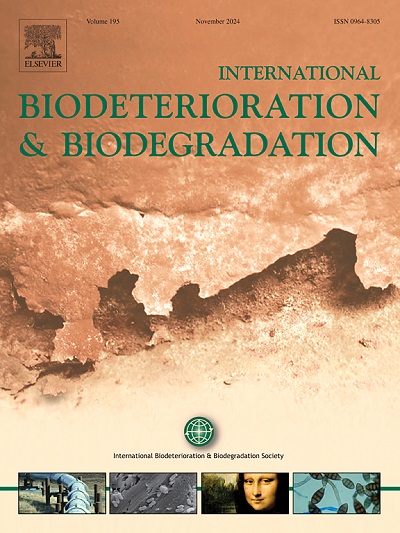Coexistence of diverse metabolic pathways promotes p-cresol biodegradation by Bacillus subtilis ZW
IF 4.1
2区 环境科学与生态学
Q2 BIOTECHNOLOGY & APPLIED MICROBIOLOGY
International Biodeterioration & Biodegradation
Pub Date : 2024-10-07
DOI:10.1016/j.ibiod.2024.105933
引用次数: 0
Abstract
The aromatic compound p-cresol is a notorious industrial pollutant characterized by its high toxicity, persistence and bioaccumulation within higher organisms. A thorough understanding of the microbial metabolic pathways involved in p-cresol degradation is critical for the design and optimization of microbial wastewater treatment systems. Despite numerous studies on the degradation pathways of p-cresol by various microbial species, the metabolic diversity within a single strain remains largely unexplored. This study investigated the metabolic mechanism of p-cresol in Bacillus subtilis ZW, a bacterium capable of degrading p-cresol. Through LC-MS analysis, we identified twelve distinct metabolic intermediates in the culture of strain ZW, leading to the proposal of three plausible degradation pathways. These include methyl hydroxylation, direct aromatic ring hydroxylation, and phosphorylation of the hydroxyl group, and all of which may concurrently contribute to p-cresol biodegradation by strain ZW. Further study showed that the genome of strain ZW harbored 47 coding genes associated with the degradation of p-cresol and its structural analogs, underscoring the metabolic versatility of this strain and its potential for xenobiotic biodegradation. These findings contribute valuable insights into the biodegradation mechanisms of pollutants. Under optimal degradation conditions of 35 °C and pH 7.0, strain ZW demonstrated the capacity to metabolize 27.5 % of p-cresol (10 mg/L) in minimal salt media within a week, and was capable of completely degrading 10 mg/L p-cresol in wastewater within five days. The potential utility of strain ZW in the bioremediation of p-cresol and other aromatic compounds is thus evident.
多种代谢途径并存促进枯草芽孢杆菌 ZW 对甲酚的生物降解
芳香族化合物对甲酚是一种臭名昭著的工业污染物,其特点是毒性高、持久性强,并在高等生物体内具有生物蓄积性。全面了解对甲酚降解的微生物代谢途径对于设计和优化微生物废水处理系统至关重要。尽管对各种微生物降解对甲酚的途径进行了大量研究,但在很大程度上,单一菌株内部的代谢多样性仍未得到探索。本研究调查了能够降解对甲酚的枯草芽孢杆菌 ZW 的代谢机制。通过 LC-MS 分析,我们在菌株 ZW 的培养液中发现了 12 种不同的代谢中间产物,并由此提出了三种可能的降解途径。这些途径包括甲基羟基化、芳香环直接羟基化和羟基磷酸化,所有这些途径都可能同时促进菌株 ZW 对甲酚的生物降解。进一步的研究表明,菌株 ZW 的基因组中含有 47 个与对甲酚及其结构类似物降解相关的编码基因,这突显了该菌株代谢的多功能性及其对异种生物降解的潜力。这些发现有助于深入了解污染物的生物降解机制。在 35 °C、pH 值为 7.0 的最佳降解条件下,菌株 ZW 能够在一周内在极少盐分的培养基中代谢掉 27.5% 的对甲酚(10 mg/L),并能在五天内完全降解废水中的 10 mg/L 对甲酚。因此,菌株 ZW 在对甲酚和其他芳香族化合物进行生物修复方面的潜在用途显而易见。
本文章由计算机程序翻译,如有差异,请以英文原文为准。
求助全文
约1分钟内获得全文
求助全文
来源期刊
CiteScore
9.60
自引率
10.40%
发文量
107
审稿时长
21 days
期刊介绍:
International Biodeterioration and Biodegradation publishes original research papers and reviews on the biological causes of deterioration or degradation.

 求助内容:
求助内容: 应助结果提醒方式:
应助结果提醒方式:


